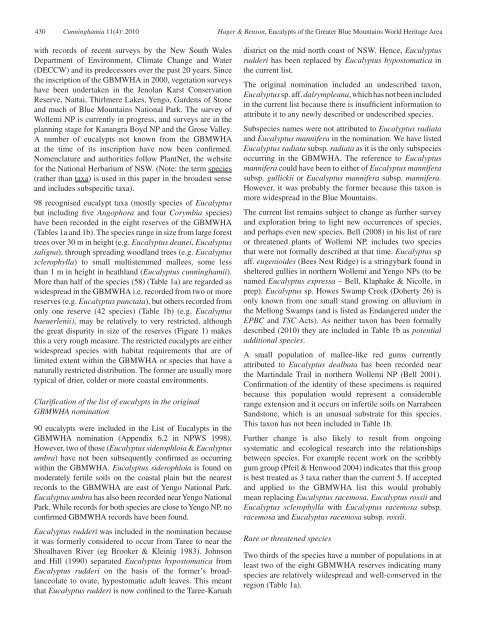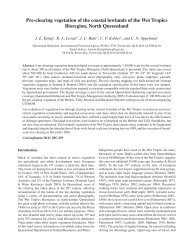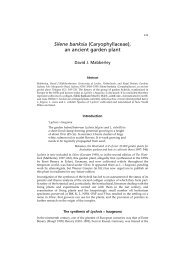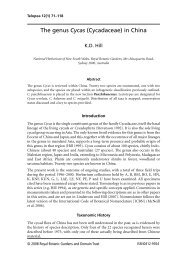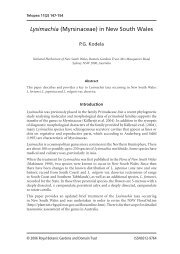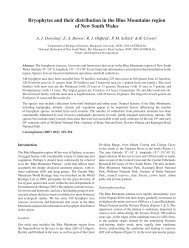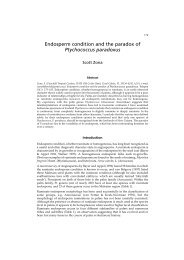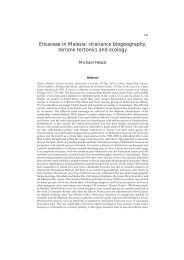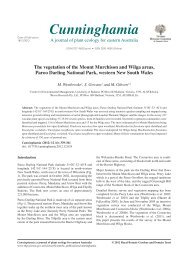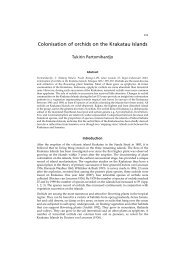The Eucalypts of the Greater Blue Mountains World Heritage Area ...
The Eucalypts of the Greater Blue Mountains World Heritage Area ...
The Eucalypts of the Greater Blue Mountains World Heritage Area ...
You also want an ePaper? Increase the reach of your titles
YUMPU automatically turns print PDFs into web optimized ePapers that Google loves.
430 Cunninghamia 11(4): 2010 Hager & Benson, <strong>Eucalypts</strong> <strong>of</strong> <strong>the</strong> <strong>Greater</strong> <strong>Blue</strong> <strong>Mountains</strong> <strong>World</strong> <strong>Heritage</strong> <strong>Area</strong><br />
with records <strong>of</strong> recent surveys by <strong>the</strong> New South Wales<br />
Department <strong>of</strong> Environment, Climate Change and Water<br />
(DECCW) and its predecessors over <strong>the</strong> past 20 years. Since<br />
<strong>the</strong> inscription <strong>of</strong> <strong>the</strong> GBMWHA in 2000, vegetation surveys<br />
have been undertaken in <strong>the</strong> Jenolan Karst Conservation<br />
Reserve, Nattai, Thirlmere Lakes, Yengo, Gardens <strong>of</strong> Stone<br />
and much <strong>of</strong> <strong>Blue</strong> <strong>Mountains</strong> National Park. <strong>The</strong> survey <strong>of</strong><br />
Wollemi NP is currently in progress, and surveys are in <strong>the</strong><br />
planning stage for Kanangra Boyd NP and <strong>the</strong> Grose Valley.<br />
A number <strong>of</strong> eucalypts not known from <strong>the</strong> GBMWHA<br />
at <strong>the</strong> time <strong>of</strong> its inscription have now been confirmed.<br />
Nomenclature and authorities follow PlantNet, <strong>the</strong> website<br />
for <strong>the</strong> National Herbarium <strong>of</strong> NSW. (Note: <strong>the</strong> term species<br />
(ra<strong>the</strong>r than taxa) is used in this paper in <strong>the</strong> broadest sense<br />
and includes subspecific taxa).<br />
98 recognised eucalypt taxa (mostly species <strong>of</strong> Eucalyptus<br />
but including five Angophora and four Corymbia species)<br />
have been recorded in <strong>the</strong> eight reserves <strong>of</strong> <strong>the</strong> GBMWHA<br />
(Tables 1a and 1b). <strong>The</strong> species range in size from large forest<br />
trees over 30 m in height (e.g. Eucalyptus deanei, Eucalyptus<br />
saligna), through spreading woodland trees (e.g. Eucalyptus<br />
sclerophylla) to small multistemmed mallees, some less<br />
than 1 m in height in heathland (Eucalyptus cunninghamii).<br />
More than half <strong>of</strong> <strong>the</strong> species (58) (Table 1a) are regarded as<br />
widespread in <strong>the</strong> GBMWHA i.e. recorded from two or more<br />
reserves (e.g. Eucalyptus punctata), but o<strong>the</strong>rs recorded from<br />
only one reserve (42 species) (Table 1b) (e.g. Eucalyptus<br />
baeuerlenii), may be relatively to very restricted, although<br />
<strong>the</strong> great disparity in size <strong>of</strong> <strong>the</strong> reserves (Figure 1) makes<br />
this a very rough measure. <strong>The</strong> restricted eucalypts are ei<strong>the</strong>r<br />
widespread species with habitat requirements that are <strong>of</strong><br />
limited extent within <strong>the</strong> GBMWHA or species that have a<br />
naturally restricted distribution. <strong>The</strong> former are usually more<br />
typical <strong>of</strong> drier, colder or more coastal environments.<br />
Clarification <strong>of</strong> <strong>the</strong> list <strong>of</strong> eucalypts in <strong>the</strong> original<br />
GBMWHA nomination<br />
90 eucalypts were included in <strong>the</strong> List <strong>of</strong> <strong>Eucalypts</strong> in <strong>the</strong><br />
GBMWHA nomination (Appendix 6.2 in NPWS 1998).<br />
However, two <strong>of</strong> those (Eucalyptus siderophloia & Eucalyptus<br />
umbra) have not been subsequently confirmed as occurring<br />
within <strong>the</strong> GBMWHA. Eucalyptus siderophloia is found on<br />
moderately fertile soils on <strong>the</strong> coastal plain but <strong>the</strong> nearest<br />
records to <strong>the</strong> GBMWHA are east <strong>of</strong> Yengo National Park.<br />
Eucalyptus umbra has also been recorded near Yengo National<br />
Park. While records for both species are close to Yengo NP, no<br />
confirmed GBMWHA records have been found.<br />
Eucalyptus rudderi was included in <strong>the</strong> nomination because<br />
it was formerly considered to occur from Taree to near <strong>the</strong><br />
Shoalhaven River (eg Brooker & Kleinig 1983). Johnson<br />
and Hill (1990) separated Eucalyptus hypostomatica from<br />
Eucalyptus rudderi on <strong>the</strong> basis <strong>of</strong> <strong>the</strong> former’s broadlanceolate<br />
to ovate, hypostomatic adult leaves. This meant<br />
that Eucalyptus rudderi is now confined to <strong>the</strong> Taree-Karuah<br />
district on <strong>the</strong> mid north coast <strong>of</strong> NSW. Hence, Eucalyptus<br />
rudderi has been replaced by Eucalyptus hypostomatica in<br />
<strong>the</strong> current list.<br />
<strong>The</strong> original nomination included an undescribed taxon,<br />
Eucalyptus sp. aff. dalrympleana, which has not been included<br />
in <strong>the</strong> current list because <strong>the</strong>re is insufficient information to<br />
attribute it to any newly described or undescribed species.<br />
Subspecies names were not attributed to Eucalyptus radiata<br />
and Eucalyptus mannifera in <strong>the</strong> nomination. We have listed<br />
Eucalyptus radiata subsp. radiata as it is <strong>the</strong> only subspecies<br />
occurring in <strong>the</strong> GBMWHA. <strong>The</strong> reference to Eucalyptus<br />
mannifera could have been to ei<strong>the</strong>r <strong>of</strong> Eucalyptus mannifera<br />
subsp. gullickii or Eucalyptus mannifera subsp. mannifera.<br />
However, it was probably <strong>the</strong> former because this taxon is<br />
more widespread in <strong>the</strong> <strong>Blue</strong> <strong>Mountains</strong>.<br />
<strong>The</strong> current list remains subject to change as fur<strong>the</strong>r survey<br />
and exploration bring to light new occurrences <strong>of</strong> species,<br />
and perhaps even new species. Bell (2008) in his list <strong>of</strong> rare<br />
or threatened plants <strong>of</strong> Wollemi NP, includes two species<br />
that were not formally described at that time. Eucalyptus sp<br />
aff. eugenioides (Bees Nest Ridge) is a stringybark found in<br />
sheltered gullies in nor<strong>the</strong>rn Wollemi and Yengo NPs (to be<br />
named Eucalyptus expressa – Bell, Klaphake & Nicolle, in<br />
prep). Eucalyptus sp. Howes Swamp Creek (Doherty 26) is<br />
only known from one small stand growing on alluvium in<br />
<strong>the</strong> Mellong Swamps (and is listed as Endangered under <strong>the</strong><br />
EPBC and TSC Acts). As nei<strong>the</strong>r taxon has been formally<br />
described (2010) <strong>the</strong>y are included in Table 1b as potential<br />
additional species.<br />
A small population <strong>of</strong> mallee-like red gums currently<br />
attributed to Eucalyptus dealbata has been recorded near<br />
<strong>the</strong> Martindale Trail in nor<strong>the</strong>rn Wollemi NP (Bell 2001).<br />
Confirmation <strong>of</strong> <strong>the</strong> identity <strong>of</strong> <strong>the</strong>se specimens is required<br />
because this population would represent a considerable<br />
range extension and it occurs on infertile soils on Narrabeen<br />
Sandstone, which is an unusual substrate for this species.<br />
This taxon has not been included in Table 1b.<br />
Fur<strong>the</strong>r change is also likely to result from ongoing<br />
systematic and ecological research into <strong>the</strong> relationships<br />
between species. For example recent work on <strong>the</strong> scribbly<br />
gum group (Pfeil & Henwood 2004) indicates that this group<br />
is best treated as 3 taxa ra<strong>the</strong>r than <strong>the</strong> current 5. If accepted<br />
and applied to <strong>the</strong> GBMWHA list this would probably<br />
mean replacing Eucalyptus racemosa, Eucalyptus rossii and<br />
Eucalyptus sclerophylla with Eucalyptus racemosa subsp.<br />
racemosa and Eucalyptus racemosa subsp. rossii.<br />
Rare or threatened species<br />
Two thirds <strong>of</strong> <strong>the</strong> species have a number <strong>of</strong> populations in at<br />
least two <strong>of</strong> <strong>the</strong> eight GBMWHA reserves indicating many<br />
species are relatively widespread and well-conserved in <strong>the</strong><br />
region (Table 1a).


